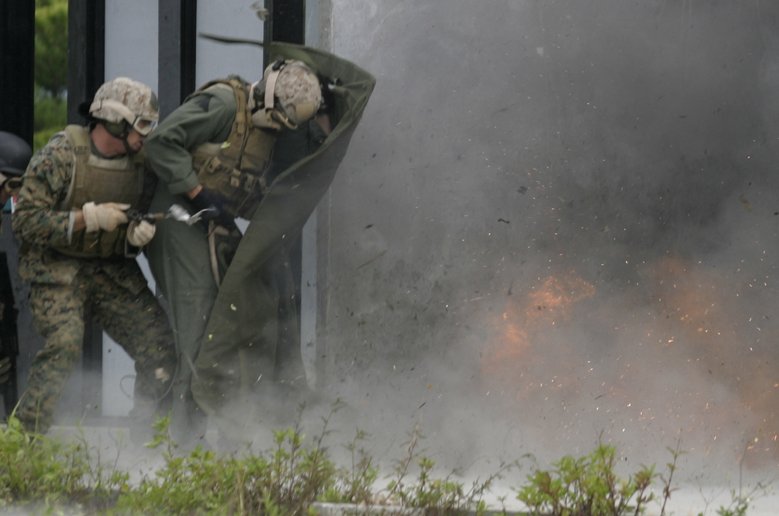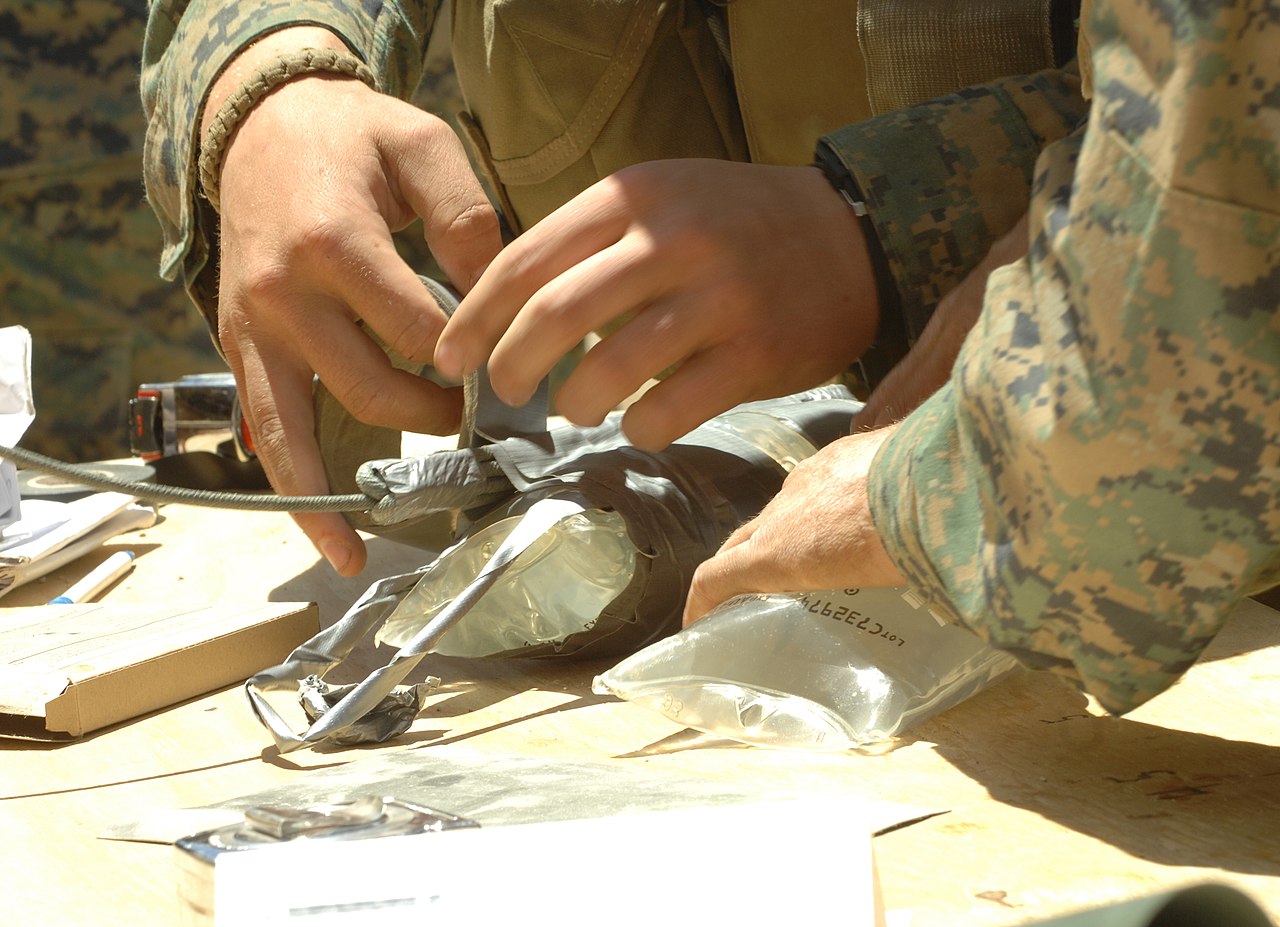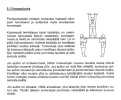Välttämättä suomalaisesta näkökulmasta ei kovin validi pointti, mutta r-vaunujen konetykit ovat aika tehokkaita seinän rikkojia, toki TST-vaunun etuna on se että koko aika monta huonetta tunkeutumispaikan ympäriltä on hetken aikaan poissa pelistä. Ja samalla tulituki rankennukseen tunkeutumiselle on on kohtuu hyvällä tolalla...
12.7mm löytyy, mutta sen teho on aika kyseenalainen sisäänmenoreiän luomiseen edes betoniseinään tai lekaharkkoseinään (syynä ei materiaalin lujuus vaan sidos muihin harkkoihin). 40mm KrKK on sitten vähän toinen juttu, mutta mille materiaalille se sitten on tehokas? Luulisi että lekaharkko ja siitä keveämpi materiaali on helppoa, raudoitettu betoni liian sitkeää.
Yksi aspekti on vielä, että mistä vertikaalisesti tunkeudutaan. Jos on vain yksi suunta, parasta saattaisi olla tulla katolta - siis ylhäältä alas - mutta taitaapa se katutaso olla useammin vaihtoehto.
Toki topikin nimi on rakennukseen tunkeutuminen, mutta aiheeseen kai voi luokitella myös rakennuksen sisällä tapahtuva vastaava toiminta. Koska kuitenkin se rakennukseen tunkeutuminen ulkoa käsin on suurimmassa osassa skenaarioita vain 1% koko toiminnan kuvasta. Toki merkittävässä osassa.
Jota vaan ryhmäkohtaiset havainnot AKE-toiminnasta Fallujahssa kiinnostaa niin suosittelen:
http://www.military.com/forums/0,15240,79595,00.html
Top-down advantages are:
* Surprising the enemy by moving from the top down may throw the enemy off balance. The enemy's defenses may not be prepared for a top-down assault, and the squad could overwhelm the enemy rapidly.
* The squad has more momentum when moving down the ladder wells.
* If the squad knows that the enemy is inside, the roof can be breached in order that grenades and explosives can be dropped in.
* The enemy's egress routes are greatly reduced because the squad can isolate the house by holding security on the back alleys and the front of the house from the roof.
Top-down disadvantages are:
* Once the squad makes entry and contact is made, pulling out of the structure is extremely difficult. This limits the options for the squad leader on how to engage the enemy. The structure must be flooded with Marines, and Marines have to go over the top of casualties in order to kill the enemy. Momentum must not be lost. Marines have been left behind in houses because the momentum was lost.
* If the squad decides to break contact, they are moving opposite their momentum and more casualties will result.
* Marine squads may not have enough Marines to effectively flood the structure.
* If casualties are taken they are nearly impossible to pull up the ladder well with all of their gear and a limp body. This is another reason why the structure must be flooded.
* The casualties will not receive immediate first aid because the entire squad must be committed to neutralization of the threat. The swiftness of medical attention may mean the difference between life and death.
Bottom-up advantages are:
* The squad leader has many options when contact is made. The structure does not have to be flooded.
* Momentum can be maintained in assaulting or breaking contact, and the squad leader can switch rapidly from one to the other.
* The structure can be cleared with fewer Marines because the clearing is more controlled and smooth, whereas a top-down assault is always in high gear.
* Casualties can be pulled out faster and easier simply because gravity is working for the squad.
Bottom-up disadvantages are:
* The squad is moving into the enemy's defenses. It is easy for the enemy to hold the second deck and ladder well.
* The squad is slow moving up the ladder well making it harder to maintain momentum.
* The enemy has the ability to escape by using its preplanned routes.
Overall, there should not be a standard assault method. Rather, the squad leader should understand the advantages and disadvantages of each method, assess each structure quickly, make a decision on which method to employ, and then take actions that maximize its advantages while minimizing its disadvantages.
Tuo on minusta oikeastaan tekstin mielenkiintoisin osuus koska ainakin kaikki kotimainen AKE-materiaali (kuten yleensäkin AKE-materiaali) jauhaa että hyökkäys on tehokkaimmillaan ylhäältä alas päin... Tässä on saatanallisen hyvää pohdintaa siitä että onkohan asia ihan näinkään.
Breaching.
There were three types of breaching used in Fallujah-mechanical, ballistic, and explosive. Mechanical breaching of the exterior walls of the courtyard or gate was mostly done by assault amphibious vehicles (AAVs), tanks, D-9 bulldozers, or HMMWVs. Sledgehammers and hooligans were used to breach both the metal and wooden doors of the house, but this was not-and is not-the preferred method for breaching. Sledgehammers and hooligans are slow, and they require the breacher to stand in front of the door being breached. Standing in front of the door allows the enemy to engage the breacher through the door.
Ballistic breaching was used mostly on exposed padlocks. Both M16A4s and shotguns were used. The M16A4s were employed because there was not enough shotgun ammunition for the number of locks that had to be breached. They were fairly effective on first round breaching of padlocks if the round was placed near the center. The M203 was also used. Squads would breach doors of houses that were 50 to 100 meters in front of their positions with the M203. It worked extremely well on the exterior metal doors.
The last type of breaching employed was explosive. A multitude of charges were used in order to breach walls, gates, exterior doors, and interior doors. Some of these will be discussed later in this evaluation.
An important principle that was learned in breaching is that the Marine making entry is never the breacher. The breacher should always fall in the back of the stack and never go in first. Marines have died because they followed their own breach.
In traditional MOUT training, making nonstandard entry points, such as walls and windows, is taught. Unfortunately, Marines were responsible for clearing 50 to 60 structures a day. There simply was not enough time or explosives to breach the walls or barred windows. Almost all of the entry points were existing doors.
Speed is the most significant factor in all types of breaching. If one method of breaching is not working, then the breacher must quickly transition to a different type. Standing in front of a door and beating it with a sledgehammer for 10 minutes is unacceptable. The breacher must be able to employ the different methods. The squad leader must ensure that the breacher has the necessary equipment and explosives for each type. Every time the squad is stalled because of a breach, it is placed in a vulnerable position. Breaching swiftly and effectively is necessary in order for the squad to maintain momentum.
Tuo alleviivattu kohta on aika merkittävä. Kuitekin olosuhteet meillä ovat hyvin toisenlaiset ja mm kaupunkijääkäreillä ei taida montaa rakennusta tyypilliseen hyökkäykseen kuulua. Siksi hommaa pitäisi osata lukea siinä kontekstissa kuin se on annettu. Tämä koskee oikeastaan koko tekstiä, siksi suosittelen lukemaan koko tekstin. Fallujahin arkkitehtuuri on hyvin toisenlaista kotimaahan verrattuna ja vihollinenkin on ainakin jossakin määrin: erityisesti marttyyrit-tyypit jotka taistelevat kuollakseen, sissi-taistelijat taas suosivat tuliylläköitä ja irtaantumista. Meillä vastapuoli ehkä kuitenkin taistelee sitä että se pyrkii pitämään sen mitä se saa haltuunsa.
Kuitenkin väittäisin että 80-90% tekstistä on erittäin paikkaansa pitävää myös meillä.
Tässä vaiheessa on myös sanottava että rakennukset olivat pääasiassa täyttä tiiltä, eli käkrien käyttömahdollisuudet ovat erittäin hyvät. Sirpaleet eivät tule seinän läpi. Arkkitehtuuri aika monotonista läpi kaupungin joka helpotti varmaan aika paljon johtamistoimintaa.
By far, the best two supporting arms used were tanks and CAATs. Tanks and CAATs were the infantryman's best friends. The battle would have been incredibly bloodier if it had not been for tanks and CAATs. The tanks were able to provide a 120mm direct fire weapon at the location of any contact within a matter of minutes. The thermal sites were able to pinpoint the exact position of snipers and then effectively neutralize them within seconds. CAAT sections used their M2 .50 caliber machineguns and Mk 19 grenade launchers to breach as well as destroy buildings from which fire was received. In addition, CAAT Marines helped by clearing buildings that lined the street in their lanes. The infantry should never attack in MOUT without tanks or CAATs.
Mortars and artillery proved effective by forcing the enemy to stay in the houses and fight the Marines in the street.
Tuo CAAT-osasto tarkoittaa on siis porukka joka liikkuu ajoneuvoilla sillä on sekä KK että PST-aseistusta. Noita tyypillisesti käytetään sivustojen tiedustelussa ja suojaamisessa, erittäin liikkuvia ja kokoonsa nähden tulivoimaisia. About 9-12 Hummeria käsittävä osasto jolla on niin .50cal KK:ta, 40mm KrKK:ta sekä TOW:ja. Ylättäen teksti ei mainitse TOW:ja kertaakaan... Tämä ei varmasti tarkoita etteikö niitä olisi käytetty vaan tarkoittaa sitä että niistä ei saa julkisesti puhella. Muistini mukaan Colby Buzzell blogissaan meinasi joutua aiheesta kuseen kun kertoi että TOW:lla ammuttiin minareettiin piiloitunutta sissiä.
Demolitions
The majority of explosives used during the fight for Fallujah will not be mentioned here. The few that will be explained have the common theme of being obscure and may be forgotten if they are not written down. Each explosive device was developed in response to the enemy's tactics and has been proven to work.
The following is a list of explosives, a description, and their uses:
* "Eight ball." A one-eighth stick of Composition 4 (C4) explosives used for breaching both interior and exterior doors-effective and doesn't use a lot of C4.
* "House guest" (named by 2d Squad, 1st Platoon, Company I, 3/5 (1/3/5). Propane tanks placed in the central hallway with C4 used to ignite them. Creates a fuel air explosive. Used for bringing down a house when contact is made inside. Propane tanks must be full.
* A 60mm or 81mm white phosphorous mortar round, wrapped three times with detonation cord, and a one-quarter or one-half stick of C4. Used when contact is made in a house, and the enemy must be burned out.
* Molotov cocktails. One part liquid laundry detergent and two parts gas. Used when contact is made in a house, and the enemy must be burned out.
All Marines should be familiar with explosives and proper placement of the charge for breaching. Any Marine should be able to cut a time fuse, crimp a blasting cap, and put the blasting cap in C4.
Osa vähän järeämpiä konstejä.

Etenkin tuo "House Quest". Toki ei kuulu enää rakennukseen tunkeutumiseen itsessään










